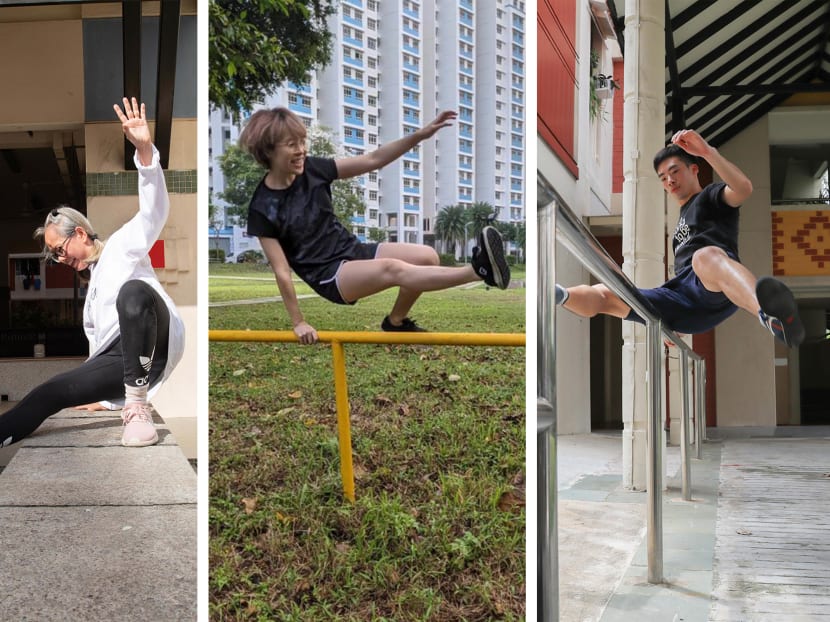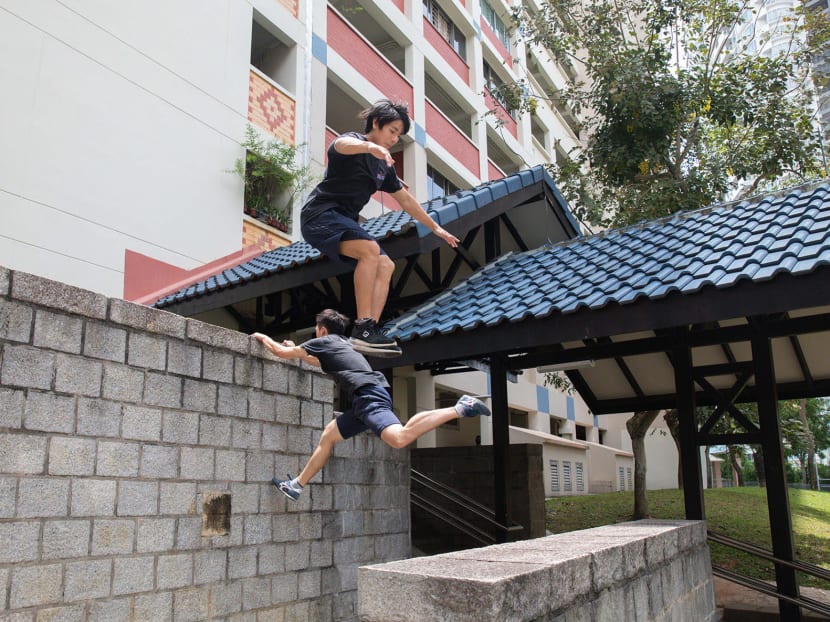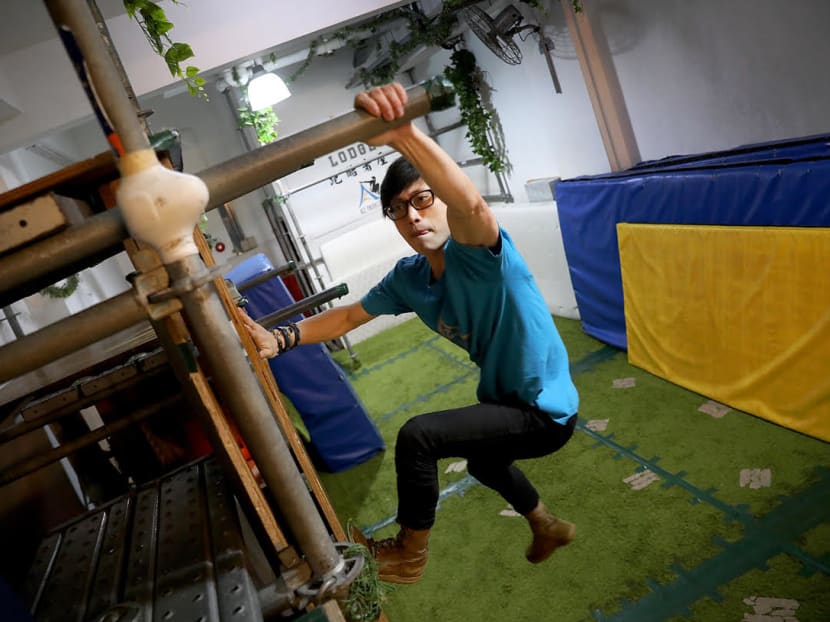Not just a sport for young men, parkour draws women, older folk who learn to roll, jump, crawl
SINGAPORE — Parkour may be dominated by younger men looking to hone their agility as they leap from obstacle to obstacle, but there is a small albeit growing number of women and older participants who are finding their place in the sport.

Parkour practitioners (from left to right) Lim Sing Yuen, 58, Janel Ang, 26, and parkour coach Tan Shie Boon, 29.
- Housewife Lim Sing Yuen, who took up parkour at 57, is among an older group of S’poreans who have joined the sport
- While she struggled at the start, she is now more confident about her movements
- Parkour coaches said the sport is structured, progressive, and moves that appear dangerous come with hours of training
- They said the perception of parkour is improving, but more needs to be done to improve its legitimacy
SINGAPORE — Parkour may be dominated by younger men looking to hone their agility as they leap from obstacle to obstacle, but there is a small albeit growing number of women and older participants who are finding their place in the sport.
When housewife Lim Sing Yuen, 58, took up the sport at the start of last year, she was surprised to learn that there was a class for people in their 50s and 60s, with about eight to 10 participants.
“I thought that was good, as I wouldn’t be a fish out of water — at least it’s my age group,” she said.
The aim of parkour is to get from one point to another in a complex, often urban environment without any assisting equipment, and in the fastest and most efficient way possible.
This can involve movements such as running, climbing, swinging and jumping around obstacles, including pillars, benches and railings.
When she first started, Ms Lim struggled.
But her coach Tan Shie Boon made the training safe by ensuring that they jumped only from lower heights such as off benches, and focused more on building strength and balance.
The mother of three teenagers, who attends classes once or twice weekly, said: “Parkour isn’t just about who can climb the highest wall; it’s about how you manage your physicality with what the environment is.
“For older people, managing how you fall down, and managing jumps from low heights and balance, all these things are important as we age.”
Younger women are joining the fray, too.
When Ms Janel Ang, 26, took up parkour in August last year after reading about it in an academic paper, she was the only woman in her class of five to eight people.
Even when other girls joined later on, they were typically younger and came with their brothers.
“I think it is quite rare for someone like me, (a woman) in her 20s, just coming in because they want to try this as a hobby,” said the master’s student at Lasalle College of the Arts.
“I tried asking some of my female friends to come, but they were very cautious.”
While the movements left her with bruises as a beginner, she has a higher pain tolerance now and has practised enough to execute her moves safely without getting hurt.
She said that she got to know several female parkour practitioners online, and how they practise the sport is very different.
“For example, instead of just jumping (around) with high impact, parkour can also be more flowy and elegant,” she said.
She goes for classes thrice a week and has become more athletic over time.
.embed-container { position: relative; padding-bottom: 56.25%; height: 0; overflow: hidden; max-width: 100%; } .embed-container iframe, .embed-container object, .embed-container embed { position: absolute; top: 0; left: 0; width: 100%; height: 100%; }PARKOUR’S CHANGING IMAGE
Ms Lim’s coach, Mr Tan, is the managing director of Move Academy, which offers parkour classes.
The 29-year-old has been coaching parkour for about five years, and began doing so after a year in the sport.
When he took up the activity, his parents were worried.
“But eventually they became more encouraging… when my parents started to see that I was more serious about it.”
He even taught his 56-year-old mother some moves and she still does the sport till this day.

Mr Koh Chen Pin, Move Academy’s parkour head coach, has been taking part in parkour for more than a decade and has been a coach since 2012.
The 27-year-old has also competed in countries such as Canada, Vietnam and Australia.
The duo from Move Academy were also recently featured in Scope, a Mediacorp content brand that focuses on social issues of concern to young people.
Mr Koh said that the sport is commonly perceived as a dangerous one, but this is not necessarily the case.
“When parents see their kid jump above head-height or over a gap, they think they will fall,” he said.
“But, before they even stand up there, they have already gone through all the possible ways that they would fail the jump and made sure that they avoid letting that happen.”
His students undergo training from the “ground up”. For instance, they will start with moves close to the ground, such as crawling and rolling, and progress to jumping from intermediate heights only after they have mastered the basics.
Despite the traction the sport has garnered here, some practitioners still face resistance from worried parents.
When university student Christopher Yeow told his mother that he was interested in taking up the sport in 2018, she refused to pay for his lessons.
“If she came and saw the kind of training that we do, she will see that it is very safe,” said the 22-year-old.

Agreeing, his coach Tan Chi Ying, founder of parkour training academy A2 Movements, said that the impression of parkour had been shaky in the past but is improving on account of improved outreach and awareness.
“Nowadays, when someone is on a rooftop or gets into a bad accident, they don’t immediately attribute it to parkour,” said the 35-year-old.
Mr Tan values the mentorship that he can offer and aspires to be a good role model, so that his students can learn to be better athletes.
Mr Koh, the head coach at Move Academy, said that those who claim to do parkour but make news for illegal acts, such as trespassing or causing public nuisance, have no place in the parkour community.
When he sees his students post videos of themselves online engaging in reckless or life-endangering stunts, he will make sure they are properly counselled.
“They just need to make sure they know the consequences of missing a jump.”
TAKING THE SPORT FORWARD
Ultimately, the parkour coaches hope that the sport would gain more legitimacy, which will then encourage more people to take it up.
“The goal is to become a recognised sport, so we can get more government support for grants and maybe a parkour park,” said Mr Koh.
To help the sport gain legitimacy, he leads Parkour (Singapore), the main official community for practitioners here.
He also organised Lion City Gathering, a parkour and free-running gathering in 2019. Held at The Star Vista shopping complex in Buona Vista, it was the biggest event of its kind in Asia.
In response to queries from TODAY, the National Youth Council said that through the National Youth Fund, the council supported Parkour (Singapore) in organising the Lion City Gathering from 2017 to 2019. Parkour (Singapore) did not apply to host the event last year owing to the Covid-19 pandemic.
The council added that the 2015 and 2016 editions of the Shine Festival had also featured parkour in its programming as part of efforts to engage youth. The festival nurtures emerging interests and creativity among young people.
“The National Youth Fund will continue to support eligible ground-up youth initiatives that benefit the community,” said the council. “The community should observe and ensure safety while engaging in these sports activities.”
TODAY also contacted eight town councils here to find out about their rules governing parkour. Five town councils did not respond and two declined comment.
A spokesperson for the Marine Parade Town Council, the only one that replied, said that in the manner of most common sports or exercises, parkour is not illegal within the bounds of the town council.
Even so, practitioners of the sport are advised to be considerate and to take precautions. These include not damaging common property, trespassing on restricted areas including rooftops, and putting themselves or others in danger.








